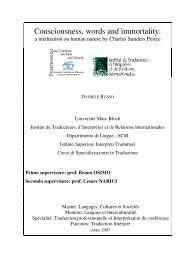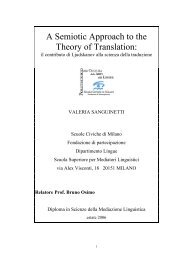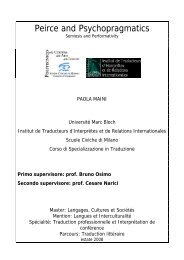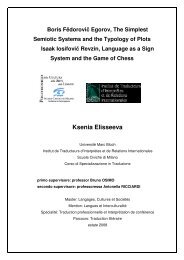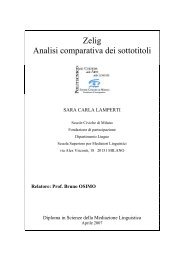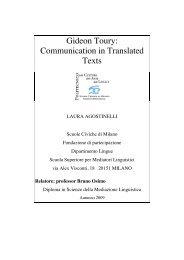Relatore: Professor Bruno OSIMO - Bruno Osimo, traduzioni ...
Relatore: Professor Bruno OSIMO - Bruno Osimo, traduzioni ...
Relatore: Professor Bruno OSIMO - Bruno Osimo, traduzioni ...
Create successful ePaper yourself
Turn your PDF publications into a flip-book with our unique Google optimized e-Paper software.
These are naturally desirable qualities of all translators; however as far as the<br />
experimental translation task is concerned, the emphasis on quantity has<br />
clearly resulted in low quality. However, it should be stressed that Lucy’s poor<br />
success in translating may be limited to the experimental situation; her<br />
conduct may be successful in translating routine texts on the job.<br />
Lucy’s nonchalant translational behaviour can also be explained through<br />
social-psychological factors, namely by looking at the subjects’ role behaviour<br />
in the experiment. It seems that role theory, particularly the notion of role<br />
distance (Goffman 1961) 7 can offer useful insights for understanding the<br />
subjects’ behaviour (see also Jääskeläinen 1996b).<br />
In role theory human behaviour is analysed in terms of the roles people<br />
perform in society. Goffman (1961: 93) defines roles as ‘the typical response of<br />
individuals in a particular position’. However, people do not always produce<br />
‘the typical response’ expected of them, i.e. people do not always live up to<br />
their roles. Goffman therefore maintains that typical roles must ‘be<br />
distinguished from the actual role performance of a concrete individual in a<br />
given position’ and, it could be added, in a given situation. Roles carry with<br />
them a large array of expectations which serve to identify individuals; in a<br />
sense, we are defined (correctly or incorrectly) by our roles. Furthermore,<br />
roles involve norms which govern the behaviour of individuals in particular<br />
positions. Consequently, roles are closely related to issues of self-image and<br />
the image conveyed to other people, which may or may not coincide.<br />
According to Goffman (1961: 87):<br />
7 I am grateful to Stephen Condit for bringing this reference to my attention.<br />
48





